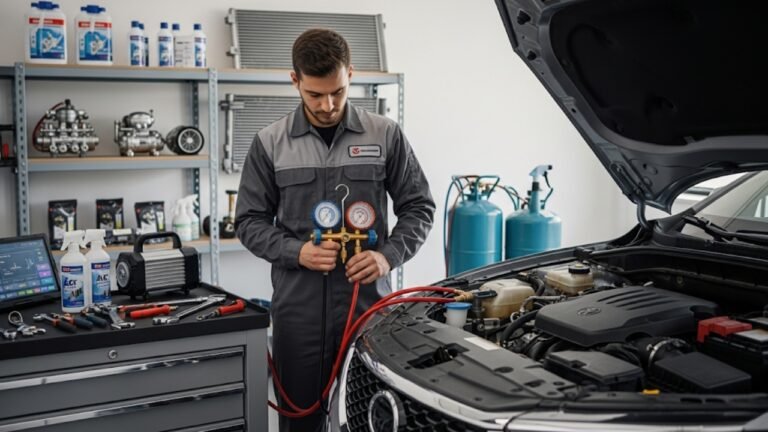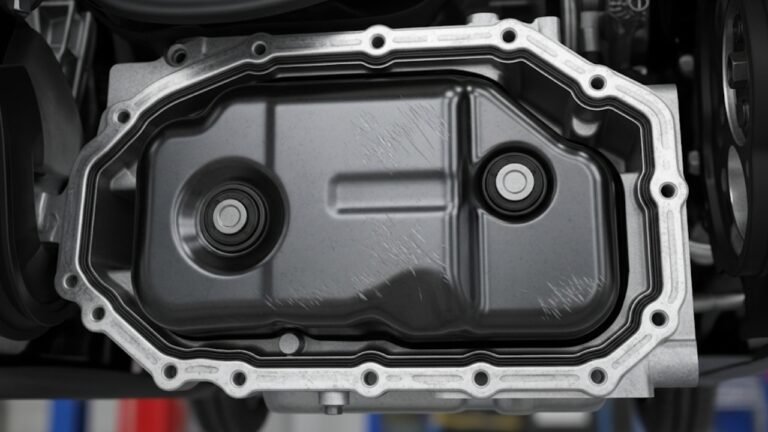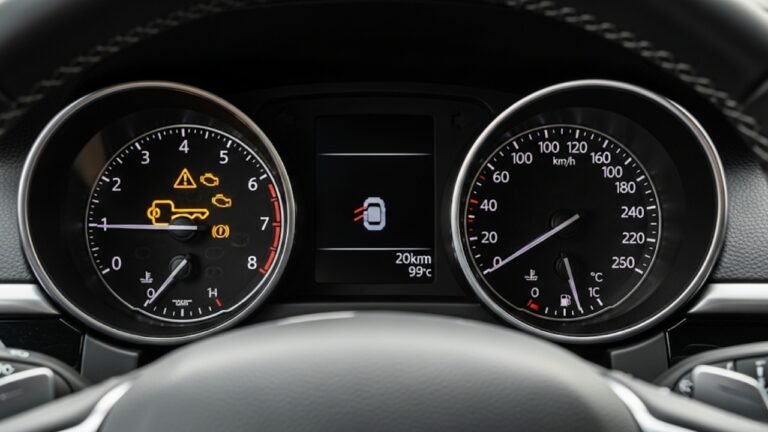How to Reset Ford F150 Check Engine Light: Quick & Easy Solutions

If you’re driving your Ford F150 and suddenly see that dreaded check engine light glow on your dashboard, don’t panic. It’s one of those small lights that can make your heart skip a beat—but often, it’s not as serious as it seems. In most cases, resetting it is something you can do yourself, without rushing to the mechanic. The trick lies in knowing how to reset the Ford F150 check engine light correctly, and understanding why it came on in the first place.
Think of your truck like a loyal friend—it tries to tell you when something doesn’t feel right. That tiny orange light is your truck’s way of saying, “Hey, something’s off. Let’s fix it.” In this guide, we’ll walk you through everything you need to know—from the main causes of the check engine light to easy step-by-step resetting methods. You’ll also learn how to prevent it from coming back, saving yourself time, money, and unnecessary stress.
Why Does the Check Engine Light Come On in a Ford F150?

The check engine light in your Ford F150 is part of its onboard diagnostic system (OBD-II). It monitors your truck’s systems to make sure everything’s running as it should. When the system detects something unusual—like poor emissions or sensor malfunctions—it triggers the light to alert you.
Here are some common reasons the light might appear:
-
Loose or damaged gas cap: Surprisingly, this is one of the top causes. If your gas cap isn’t tightened properly, it can trigger the system to think there’s a fuel leak.
-
Faulty oxygen sensor: This sensor measures the amount of oxygen in your exhaust. If it malfunctions, it can cause poor fuel economy and activate the check engine light.
-
Malfunctioning mass airflow sensor: This part helps balance air and fuel for combustion. When it’s dirty or damaged, it affects performance.
-
Old spark plugs or ignition coils: Misfiring or inefficient combustion often leads to warning lights.
-
Exhaust system issues: Blocked or damaged catalytic converters can trigger a warning signal.
To understand how serious the problem is, pay attention to how your truck behaves. If it’s running normally, the issue might be minor. But if you notice rough idling, stalling, or power loss, it’s best to diagnose it quickly before resetting the light.
Understanding the Purpose of the Check Engine Light
The check engine light isn’t there to scare you—it’s there to protect your engine. When it turns on, it means the truck’s computer has detected something outside the normal range of performance. The good news? The light doesn’t always mean a costly repair is ahead.
There are two types of check engine lights you might see:
-
Steady light: Indicates a minor issue, like a loose gas cap.
-
Flashing light: Signals something serious, such as an engine misfire, which can damage the catalytic converter.
Think of it like a fever in a human body—it’s a sign something needs attention, not a death sentence. The key is to diagnose and reset properly. Once you know the root cause, you can confidently move forward to reset the warning and restore your dashboard’s peace.
How to Reset Ford F150 Check Engine Light (Step-by-Step Guide)
If you’re tired of that little orange light staring at you every morning, don’t worry. Resetting the Ford F150 check engine light is surprisingly easy. You just need a few tools, some patience, and a bit of confidence.
Here’s a simple step-by-step guide you can follow:
Step 1: Check for Visible Problems
Before diving into resets, do a quick inspection. Make sure the gas cap is tight, the engine bay is clean, and no cables or hoses look damaged. Many times, the fix is as simple as tightening a loose cap.
Step 2: Use an OBD-II Scanner
Plug an OBD-II scanner into the port under your dashboard (usually near the steering column). This device reads the error codes stored in your truck’s computer. Each code points to a specific issue—like a bad oxygen sensor or a misfire.
Once you’ve read the codes, you can look them up online or in your owner’s manual. This helps you know whether the problem is minor or needs professional attention.
Step 3: Clear the Error Codes
After noting the issues, use the OBD-II scanner to clear the codes. Most scanners have a “Clear Codes” or “Erase” function. This action resets the check engine light. However, if the problem isn’t fixed, the light will come back on.
Step 4: Disconnect the Battery
If you don’t have an OBD-II scanner, you can manually reset the system by disconnecting your truck’s battery.
-
Turn off the ignition and remove the key.
-
Use a wrench to disconnect the negative cable from the battery.
-
Leave it disconnected for 10–15 minutes.
-
Reconnect the cable, ensuring it’s secure.
This step clears the truck’s stored power, effectively resetting the onboard computer and removing the check engine light.
Step 5: Test Drive Your Truck
Start your Ford F150 and take it for a short drive—around 10 to 15 minutes. The check engine light should remain off if the issue is resolved. If it returns, it means there’s still an active problem that needs attention.
By following these simple steps, you can clear the check engine light and restore your dashboard to normal. It’s a quick, no-cost solution that can save you a trip to the mechanic.
Alternative Reset Method: The Key-On-Key-Off Trick
Some F150 owners use the Key-On-Key-Off method as a quick fix to reset the check engine light without disconnecting the battery or using tools. Here’s how it works:
-
Insert your key into the ignition and turn it to the “On” position (do not start the engine).
-
Wait about 10 seconds, then turn it off.
-
Repeat this process three times.
-
Start the engine and check if the light has gone out.
This method resets the electronic systems in some Ford models. It doesn’t always work for deeper issues, but it’s worth trying if you need a quick fix before using more advanced methods.
Common Mistakes to Avoid When Resetting
Resetting the Ford F150 check engine light might seem simple, but there are a few things you should avoid to prevent further issues:
-
Ignoring the cause: Clearing the light doesn’t fix the problem. Always diagnose before resetting.
-
Disconnecting the battery too quickly: The computer needs a few minutes to reset; rushing the process may not work.
-
Not securing battery cables: Loose connections can trigger new electrical issues.
-
Skipping a test drive: You won’t know if the reset worked until you’ve driven the truck for a while.
Remember, the goal is not just to turn off the light but to fix what caused it in the first place.
Quick Diagnostics You Can Do at Home
Before heading to the mechanic, you can run a few simple checks on your own. Here’s a mini checklist:
| Diagnostic Step | What to Look For | Why It Matters |
|---|---|---|
| Gas Cap | Ensure it’s tight and undamaged | A loose cap triggers a false fuel leak alert |
| Air Filter | Check for clogs or dirt | Restricts airflow and affects performance |
| Battery Cables | Ensure tight and corrosion-free | Poor connections affect sensors |
| Spark Plugs | Look for wear or black residue | Affects combustion and triggers warning lights |
| Hoses | Check for cracks or leaks | Causes air leaks and incorrect sensor readings |
Performing these checks gives you a better understanding of your truck’s condition before performing a reset.
The Role of an OBD-II Scanner in Modern Diagnosis
An OBD-II scanner is like your Ford F150’s stethoscope—it listens to your truck’s digital heartbeat. It’s one of the most valuable tools for both professional mechanics and DIY owners.
When your check engine light comes on, the truck’s computer generates diagnostic codes called DTCs (Diagnostic Trouble Codes). These codes reveal exactly what system or part needs attention. Without a scanner, you’d be guessing.
You can buy a basic OBD-II scanner for under $30 online or at any auto parts store. They’re easy to use—just plug, read, and act. For even more convenience, there are Bluetooth scanners that sync with your smartphone, showing live data and even suggesting possible fixes.
Having one at home not only helps you reset the check engine light but also keeps you informed about your truck’s overall health. It’s like having a mini mechanic in your glove compartment.
Why Disconnecting the Battery Works
When you disconnect the battery, you’re essentially rebooting your truck’s computer. It clears out stored data, including the error codes that triggered the check engine light.
However, this method also resets other memory-based systems—like radio presets, clock settings, and seat positions. So, before you do it, make sure you’re okay with losing those preferences temporarily.
Think of it like restarting your smartphone when it freezes. Sometimes all it needs is a fresh reboot to clear the glitches. The same concept applies to your Ford F150.
How to Know If Your Check Engine Light Reset Worked
After performing a reset on your Ford F150 check engine light, it’s important to confirm whether it actually worked. Many drivers assume the problem is fixed the moment the light disappears—but that’s not always the case.
Here’s how you can tell if your reset was successful:
-
The light stays off after driving: Start your truck and let it idle for a few minutes. Then take it for a 10–15-minute drive at varying speeds. If the check engine light doesn’t come back, the reset worked.
-
The truck runs smoothly: No jerking, stalling, or hesitation during acceleration? That’s a good sign the underlying issue has been resolved.
-
OBD-II scan shows no active codes: Run another scan after a day or two. If no codes are detected, the system is clear.
Sometimes, the light might return after a few miles of driving. If that happens, it means your truck’s sensors have detected the same issue again—and you’ll need to inspect it further.
Preventive Maintenance to Avoid Future Check Engine Light Problems
The best way to handle a check engine light is to avoid triggering it in the first place. Your Ford F150 is a tough and reliable vehicle, but like any machine, it needs consistent care to stay in top shape.
Here are some practical maintenance tips to keep that warning light off for good:
-
Tighten your gas cap every time you refuel. This simple habit can save you from unnecessary warnings.
-
Replace air and fuel filters regularly to ensure smooth airflow and fuel efficiency.
-
Inspect spark plugs every 30,000 miles and replace them if worn.
-
Clean your mass airflow sensor using a special spray to keep it functioning properly.
-
Use quality fuel to prevent buildup in the fuel injectors and sensors.
By following these steps, you’ll reduce the chances of unexpected warning lights and keep your Ford F150 running strong for years.
Addressing Common Check Engine Light Triggers
Let’s take a closer look at the most frequent culprits behind your Ford F150 check engine light and how to deal with them:
-
Oxygen Sensor Failure:
This sensor helps regulate fuel and air balance. If it fails, your fuel efficiency drops. Replace it every 60,000–90,000 miles for optimal performance. -
Loose Gas Cap:
Believe it or not, a simple twist can solve this. Always ensure it clicks securely after refueling. -
Faulty Catalytic Converter:
This part helps control harmful emissions. If it’s clogged or damaged, you might experience poor acceleration and engine knocking. -
Bad Spark Plugs or Ignition Coils:
Misfiring or rough idling often points to these components. Regular inspection helps prevent costly repairs later. -
Mass Airflow Sensor Issues:
A dirty sensor can cause the check engine light to appear. Cleaning it with sensor-safe spray usually solves the problem.
By identifying and addressing these triggers early, you’ll keep your truck’s engine light from becoming a recurring headache.
Why Regular Inspections Matter More Than You Think
It’s easy to overlook routine inspections when your truck seems to be running fine. But the truth is, preventive care is cheaper than reactive repair.
During regular inspections, mechanics check crucial systems—like the exhaust, fuel injectors, and sensors—that can trigger the check engine light. Even a minor issue, if left unnoticed, can lead to poor performance or reduced mileage.
Regular inspections not only keep your F150 reliable but also ensure it passes emissions tests without hassle. Think of these check-ups as your truck’s “doctor visits”—a small step to prevent bigger problems down the road.
When to Visit a Professional Mechanic
While resetting the Ford F150 check engine light is simple, some cases require a professional touch. If you notice:
-
The light keeps returning after multiple resets
-
There’s a loss of power or unusual noises from the engine
-
You detect a burning smell or smoke
-
The light starts flashing instead of staying steady
Then it’s time to consult a qualified mechanic. A flashing check engine light usually indicates an active misfire that could damage your catalytic converter—a repair that can cost thousands if ignored.
A mechanic can run advanced diagnostics, test sensors, and perform repairs that go beyond what a home scanner can detect.
Tips to Keep Your Ford F150’s Engine Healthy
Owning a Ford F150 means you rely on strength, durability, and performance. To maintain that legendary reliability, here are some practical habits you can adopt:
-
Warm up your engine before long drives—especially in cold weather.
-
Change your oil and filters on schedule to avoid buildup.
-
Monitor fuel quality—bad gas can cause misfires and trigger warning lights.
-
Avoid overloading your truck; excess weight strains the engine.
-
Check tire pressure regularly—believe it or not, low pressure affects engine load and mileage.
Consistency is key. A well-maintained truck rarely leaves you stranded or surprises you with unexpected dashboard lights.
Understanding Temporary vs. Persistent Check Engine Lights
Sometimes the check engine light comes on for a short while and disappears after a few drives. This can happen if your truck detects a minor, temporary issue—like a loose cap or brief fuel mixture imbalance.
However, a persistent light that stays on or returns repeatedly suggests a deeper problem. Your truck’s computer stores error codes for a reason, and ignoring them can cause hidden damage.
A good rule of thumb:
-
If the light flashes, stop driving immediately.
-
If it’s steady, it’s safe to drive temporarily—but schedule diagnostics soon.
Your F150 communicates through that little orange light, so pay attention to its patterns.
Can You Drive with the Check Engine Light On?
Technically, yes—but only under certain conditions. If your Ford F150 check engine light is on but the truck feels normal, you can drive short distances to reach a repair shop or home.
However, if you notice poor performance, strange noises, or the light is flashing, pull over safely and turn off the engine. Continuing to drive in that condition can cause further damage, especially to the catalytic converter or oxygen sensors.
Driving with the light on is like running a marathon while injured—it might not stop you immediately, but it’ll make things worse over time.
Long-Term Benefits of Fixing and Resetting the Check Engine Light Properly
When you handle your Ford F150 check engine light the right way—by diagnosing, fixing, and resetting properly—you do more than just clear a dashboard alert. You’re protecting your engine’s lifespan and improving performance.
Here are the long-term benefits:
-
Better fuel economy: Fixing faulty sensors helps maintain ideal fuel-air ratios.
-
Improved engine performance: Smooth acceleration and cleaner combustion.
-
Reduced repair costs: Addressing small issues prevents major engine damage.
-
Enhanced resale value: A truck with no warning lights and full maintenance records attracts better buyers.
In short, a well-maintained Ford F150 isn’t just a truck—it’s an investment in dependability.
FAQs about Resetting the Ford F150 Check Engine Light
1. How long does it take for the check engine light to reset itself?
If the issue has been fixed, the check engine light may turn off automatically after 20–40 miles of driving. However, using an OBD-II scanner or disconnecting the battery provides a faster reset.
2. Will disconnecting the battery harm my Ford F150’s computer?
No, it won’t damage the computer. It only clears stored codes and temporary data. Just make sure to reconnect cables securely afterward.
3. Can I reset the light without fixing the problem?
Yes, but the light will come back. Resetting without addressing the root cause is only a temporary solution.
4. Why does the light keep returning after I reset it?
It means your truck’s system has detected the same fault again. You’ll need to inspect or replace the faulty component.
5. How much does a professional reset cost?
A mechanic might charge around $50–$100 for diagnostics and a reset. Doing it yourself with an OBD-II scanner is usually free.
6. Is it safe to drive right after disconnecting the battery?
Yes, but drive gently for the first few miles. The computer needs to relearn your driving patterns and adjust engine parameters.
7. Can cold weather trigger the check engine light?
Sometimes. Extremely cold temperatures can affect sensors or battery voltage, temporarily triggering the light.
8. Will the reset clear all warning lights on my dashboard?
No. It only resets the check engine light. Other alerts (like tire pressure or oil) have separate sensors.
Conclusion: Your Ford F150 Deserves Proper Care
Resetting the Ford F150 check engine light doesn’t have to be intimidating. Whether you use an OBD-II scanner or the simple battery disconnect method, the process is quick and effective. But remember—resetting is just part of the solution. The real key lies in finding out why the light came on in the first place.
Your Ford F150 is built to last, but only if you listen when it speaks. By diagnosing issues early, performing regular maintenance, and following preventive tips, you’ll keep your truck running strong and dependable—mile after mile.
So, next time that little orange light pops up, take a deep breath. You now know exactly what to do.





